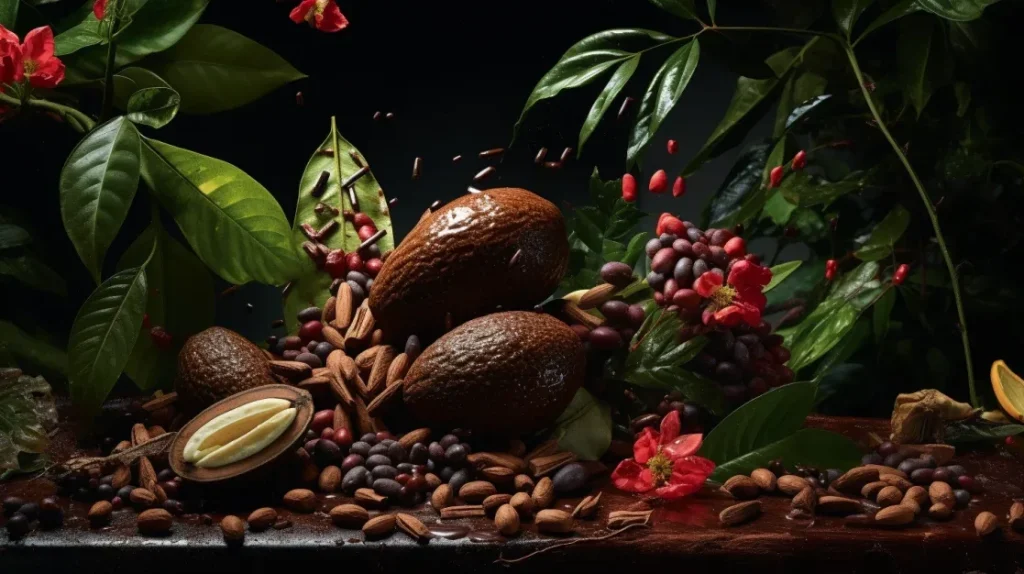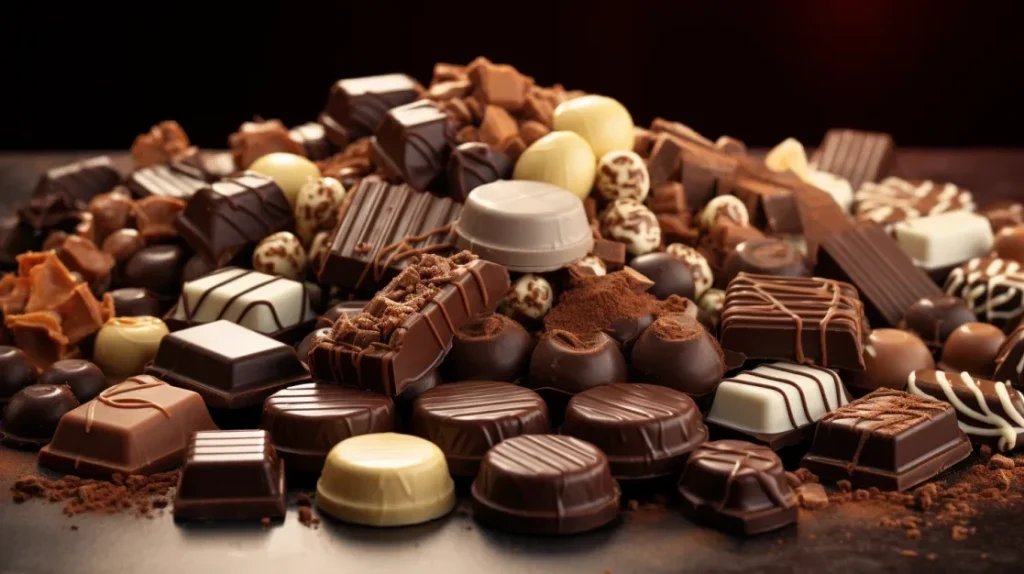Table of Contents
Are you ready to dive into the deliciously sweet world of chocolate? Get ready to have your taste buds tantalized and your mind blown as we unravel the sweet truth about whether chocolate can be classified as candy.
In this article, we will delve into the history, definition, ingredients, manufacturing process, flavors, varieties, consumption, nutritional profile, and marketing of chocolate. By the end, you’ll have all the facts you need to answer the age-old question: is chocolate candy?
Prepare to be enlightened and entertained as we separate fact from fiction and discover what makes chocolate irresistible. So grab a bar, sit back, and get ready to indulge in the ultimate chocolatey debate. Let’s satisfy our curiosity and uncover the truth about everyone’s favorite guilty pleasure.
Key Takeaways Of “Is Chocolate Candy”
- Chocolate has a rich history and cultural significance, enjoyed worldwide and associated with celebrations and rituals.
- Chocolate can be classified as candy due to its sweet taste, indulgent nature, and association with special occasions.
- Dark chocolate, in particular, has potential health benefits, including antioxidants and potential heart health benefits.
- Effective marketing strategies for chocolate involve branding, packaging, and advertisements that appeal to the target audience and create brand loyalty.
What is Chocolate Candy?
Chocolate candy is a type of candy that falls under the candy category of sweet candy. While there are various types of sugar candies, such as cotton candy and soft candies, chocolate candy stands out for its rich and indulgent taste. It is made from cocoa beans and is often combined with other ingredients like sugar and milk to create a smooth and creamy texture. Whether it’s a chocolate bar, truffles, or chocolate-coated nuts, chocolate candy is beloved by many for its irresistible sweetness and melt-in-your-mouth goodness.
Chocolate candies come in various forms, including candy bars, bonbons, truffles, and chocolate-covered treats. They are enjoyed by people of all ages as a delightful indulgence. From chocolate bars to chocolate chip cookies, there are endless possibilities to satisfy your sweet tooth.
It is important to note that while chocolate candy may be a delicious treat, it should be consumed in moderation. Excessive consumption may lead to health issues, such as blood pressure spikes and blood sugar level imbalances. So, enjoy the sweetness of chocolate candy, but remember to keep it in moderation for a balanced lifestyle.
The History of Chocolate
The history of chocolate is a rich tapestry of cultural exchange and technological innovation.
The origins of chocolate can be traced back to the ancient civilizations of Mesoamerica, where it was consumed as a bitter beverage.
The Mayans and Aztecs believed chocolate had divine properties and used it in religious ceremonies.
With the arrival of the Spanish conquistadors in the 16th century, chocolate was introduced to Europe, where it underwent significant transformations.
Sugar was added to sweeten the bitter taste, and new techniques were developed to create solid chocolate bars.
Chocolate quickly became a luxury item enjoyed by the elite.
Its cultural significance grew as it spread across the globe, becoming a symbol of indulgence and pleasure.
Transitioning to the subsequent section, understanding the definition of candy is essential in determining whether chocolate falls under this category.
The Ingredients of Chocolate

In the discussion on the subtopic of the Ingredients of Chocolate, you will delve into the critical points of cocoa beans and cocoa solids, sugar and sweeteners, and additional ingredients in chocolate.
Cocoa beans and cocoa solids derived from the beans are the primary ingredients that give chocolate its distinct flavor.
Sugar and sweeteners are added to enhance the sweetness and balance the bitterness of cocoa.
Lastly, additional ingredients in chocolate may vary depending on the type and brand, such as milk, vanilla, and emulsifiers, which contribute to its texture and taste.
Cocoa beans and cocoa solids
Cacao beans are the principal ingredient in chocolate candies. These beans come from the cacao tree and are processed to create cocoa solids, butter, and powder. Different types of candy use varying amounts of these components.
Cacao beans contain compounds that are beneficial for human health. They are rich in antioxidants, which can help improve heart health. Additionally, cacao beans contain oleic acid, a heart-healthy monounsaturated fat. The caffeine content in chocolate candies also provides a mild stimulant effect.
The production of chocolate candies dates back to the 18th century and has evolved significantly since then. Today, chocolate candies can be found in various forms, such as solid bars, truffles, cakes, and drinks like hot chocolate and chocolate milk.
In conclusion, cacao beans are the key ingredient in chocolate candies, and their production and consumption have become an integral part of our culture. From the cocoa content to the different types and brands available, chocolate candies continue to be popular in grocery stores and are enjoyed by people of all ages.
Sugar and sweeteners
To satisfy your sweet tooth, you’ll likely be surprised to learn that, on average, a single milk chocolate bar contains about 24 grams of sugar, equivalent to six teaspoons.
Regarding sugar in chocolate, some alternatives can be used to sweeten the treat. Some common sugar alternatives include honey, maple syrup, agave nectar, and stevia. These alternatives can provide a different taste profile and may have other health effects than traditional sugar.
It is important to note that the health effects of sugar and sugar alternatives in chocolate are still being studied, and more research is needed to understand their impact on our health.
Moving on to the next section about additional ingredients in chocolate, let’s explore what makes this sweet treat so irresistible.
Additional ingredients in chocolate
Get ready to discover the secret ingredients that make chocolate so irresistibly delicious! In addition to cocoa solids and sugar, chocolate often contains additional elements that contribute to its unique taste and texture.
These can include milk or cream, which adds a creamy and smooth mouthfeel, and vanilla, which enhances the overall flavor. Some chocolates also feature nuts, fruit, or other flavorings, providing a delightful surprise with each bite.
While these additional ingredients may vary depending on the type of chocolate, they all play a crucial role in creating the perfect balance of flavors. Moreover, chocolate has been shown to have health benefits, such as improving mood and providing antioxidants.
Now that you know about the additional ingredients that make chocolate unique, let’s delve into the fascinating manufacturing process of this delectable treat.
The Manufacturing Process of Chocolate
Once the magical cacao beans have been harvested and transformed into liquid gold, the mesmerizing dance of sugar, milk, and cocoa butter commences, giving birth to the delectable creation we know as chocolate.
The manufacturing process of chocolate involves a careful combination of art and science. Various chocolate manufacturing techniques ensure the highest quality chocolate reaches your taste buds.
Each step is meticulously executed to create a smooth and velvety texture, from roasting and grinding the cacao beans to conching and tempering the chocolate. Quality control measures are implemented throughout the process to maintain consistency and excellence in every batch.
As the flavors and varieties of chocolate continue to evolve, the manufacturing process adapts, constantly pushing the boundaries of innovation and taste.
Transitioning into the next section, the diverse flavors and varieties tantalize chocolate lovers with their unique characteristics.
The Flavors and Varieties of Chocolate

The world of chocolate is a vibrant tapestry of flavors and varieties, each one more enticing than the last. Regarding flavors and textures, chocolate offers many options to satisfy any palate. From rich and creamy milk chocolate to intense and bitter dark chocolate, there is something for everyone.
Additionally, adding various ingredients such as nuts, fruits, and spices creates even more unique and delicious combinations. In terms of health benefits, dark chocolate is known for its antioxidant properties and potential to improve heart health. However, it’s important to remember that moderation is key when enjoying these indulgent treats.
Solid Chocolates vs. Crystalline Candies
Solid chocolates and crystalline candies are both popular types of chocolate treats. Solid chocolates, as the name suggests, are made primarily of cocoa butter and cocoa solids, giving them a rich and smooth texture. They melt slowly in the mouth, allowing the flavors to develop and linger.
On the other hand, crystalline candies, such as chocolate bars, have a crystalline structure. They are produced by cooling a sugar-based mixture, creating a rugged and crunchy texture. They often contain added ingredients like nuts, caramel, or nougat for added crunch and flavor.
While solid chocolates are more commonly associated with premium chocolate brands and artisanal creations, crystalline candies are found in various mass-produced chocolate bars and sweets.
Solid chocolates and crystalline candies have unique qualities and are enjoyed by chocolate lovers worldwide. Whether you prefer the smoothness of solid chocolates or the crunch of crystalline candies, there is a chocolate treat to satisfy every taste preference.
Types of Chocolate Candy

There are various types of chocolate candies available to satisfy different taste preferences. Some popular types include:
1. Milk Chocolate: This is a classic favorite, with a smooth and creamy texture. It contains cocoa solids, sugar, and milk powder, giving it a milder and sweeter taste.
2. Dark Chocolate: With a higher percentage of cocoa solids and less sugar, dark chocolate offers a rich, intense flavor. It is preferred by those who enjoy a slightly bitter taste.
3. White Chocolate: Although technically not a bar of chocolate, white chocolate is made from cocoa butter, sugar, and milk solids. It has a sweet and creamy flavor.
4. Filled Chocolates: These chocolates have various fillings like caramel, nuts, or fruit, adding extra texture and flavor.
5. Chocolate bars: These are solid bars of chocolate that may contain additional ingredients for added flavor, such as nuts, cookies, or candies.
6. Truffles: These are decadent chocolates with a soft and creamy ganache center, often coated in cocoa powder or chocolate.
Whatever your preference, chocolate candies offer a delectable treat for all chocolate lovers.
The Nutritional Profile of Chocolate
The nutritional profile of chocolate is quite surprising. Dark chocolate, in particular, is rich in antioxidants that protect cells from damage caused by free radicals. It also contains essential minerals like magnesium, iron, and copper. However, it’s important to consume chocolate in moderation due to its high calorie and sugar content. Excessive consumption may lead to weight gain and an increased risk of health concerns like diabetes and heart disease. Now, let’s explore the captivating world of chocolate marketing and advertising.
The Verdict: Is Chocolate Candy?

There are solid arguments for both sides when considering whether chocolate is classified as candy. Those who favor classifying chocolate as candy argue that it falls under the category due to its sweet taste, indulgence, and similarity to other confectionery chocolate products.
On the other hand, there are arguments against classifying chocolate as candy, stating that it is a separate entity with distinct qualities, such as its versatility in baking and its use in gourmet creations.
From a personal perspective, it can be concluded that while chocolate shares similarities with candy, it can also be seen as a unique and versatile treat in its own right.
Arguments for classifying chocolate as candy
Chocolate, with its rich and indulgent taste, is undeniably a delectable treat that can be classified as candy. Regarding taste preferences, many people gravitate towards chocolate’s sweet and smooth flavor, making it a popular choice for satisfying their sweet tooth.
Also, chocolate is significant in various societies, often associated with celebrations, holidays, and special occasions. Its presence in traditions and rituals further solidifies its classification as candy.
Furthermore, chocolate’s composition, typically made from cocoa beans, sugar, and milk, aligns with the ingredients commonly found in candy products. Its sweetness, texture, and overall presentation further support its classification as candy.
However, despite these arguments, there are compelling points against classifying chocolate as candy, which will be explored in the subsequent section.
Arguments against classifying chocolate as candy
You may have never realized this, but there are valid arguments that challenge the classification of chocolate as candy. While it is commonly categorized as a sweet popular treat, chocolate possesses several health benefits that set it apart from traditional candy.
Dark chocolate, in particular, is rich in antioxidants and linked to a reduced risk of heart disease and improved brain function. Additionally, chocolate holds cultural significance in many societies, used in religious ceremonies, celebrations, and even as a form of currency in the past.
Its historical and cultural importance separates chocolate sweet from the typical sugar confectionery classification of candy. As we delve deeper into the discussion, it becomes evident that chocolate’s health benefits and cultural significance deserve a separate categorization.
Frequently Asked Questions
How long have humans consumed chocolate?
Humans have been consuming chocolate for thousands of years, making it a significant part of our history and culture. Its consumption dates back to ancient civilizations and has become a beloved treat worldwide.
What is the difference between dark chocolate and milk chocolate?
Dark chocolate and milk chocolate differ in cocoa content. Dark chocolate has a higher cocoa content, typically above 70%, while milk chocolate contains lower cocoa and milk solids.
Does chocolate have any health benefits?
Indulging in chocolate can have sweet benefits for your heart health. Its antioxidants are crucial in protecting against inflammation and promoting blood flow. So go ahead, savor that chocolate guilt-free!
Are there any vegan or dairy-free chocolate options available?
Yes, there are several vegan chocolate brands and dairy-free chocolate alternatives available. These options cater to individuals who follow a vegan diet or are lactose intolerant, providing delicious chocolate treats without animal or dairy ingredients.
Can chocolate be stored for an extended period of time?
To investigate the theory of chocolate’s longevity, it is essential to understand the best ways to store it. Properly stored chocolate can last for an extended period of time, ensuring its quality and flavor remain intact.
Conclusion
Congratulations on unraveling the sweet truth about chocolate! Yes, chocolate can be classified as candy. While chocolate is derived from the cacao bean and undergoes a complex manufacturing process, it is commonly consumed as a sweet treat. Chocolate is often combined with sugar, milk, and other ingredients to create various forms of sugar candy, such as chocolate bars, truffles, and bonbons. Its rich and indulgent taste and wide availability in confectionery aisles and candy stores solidify its place as a beloved candy option for many people worldwide.



